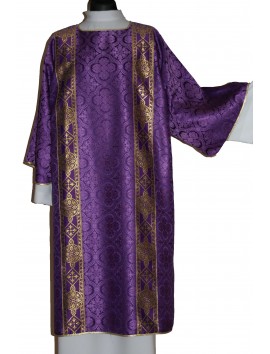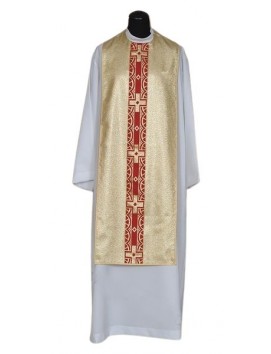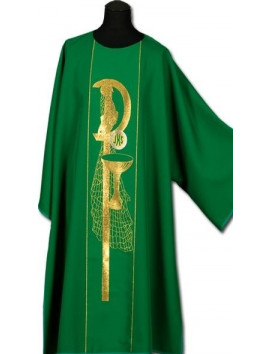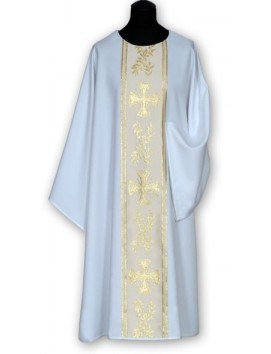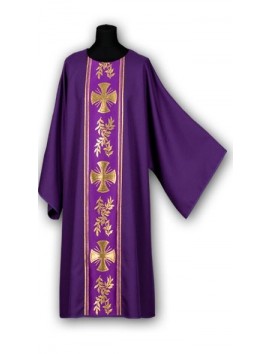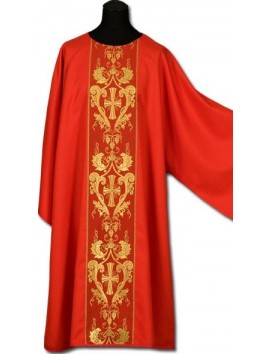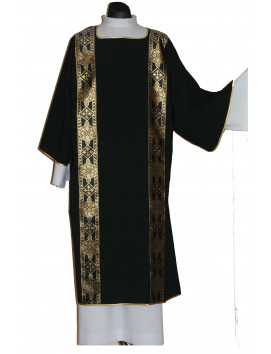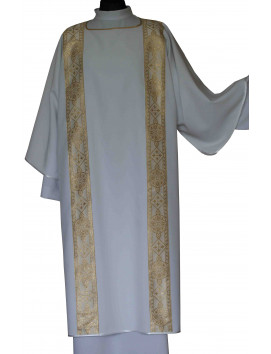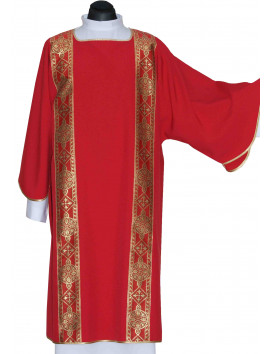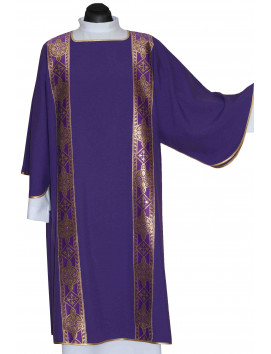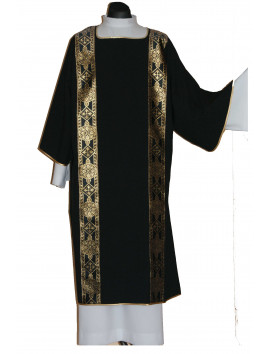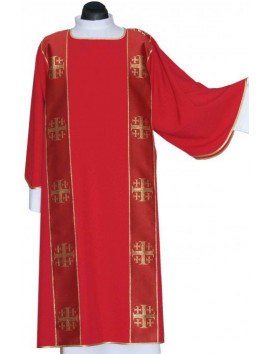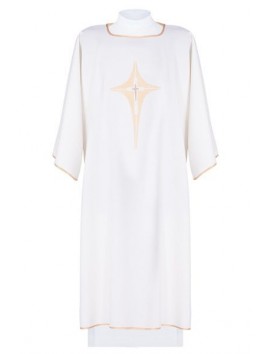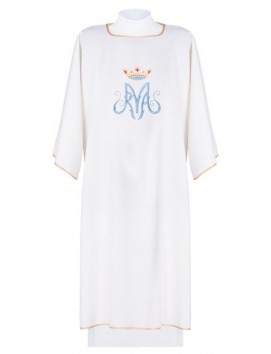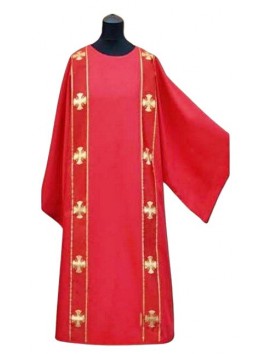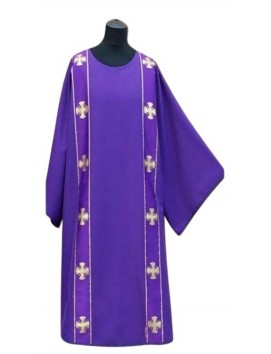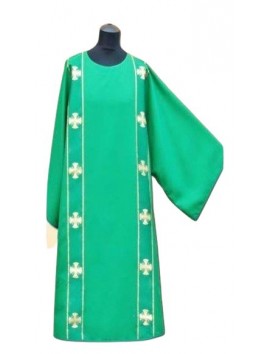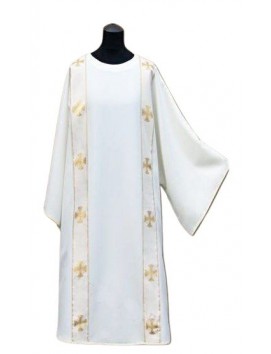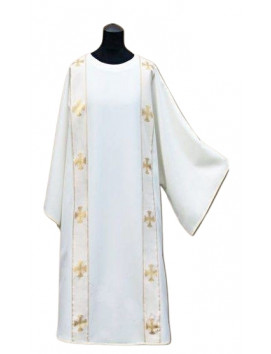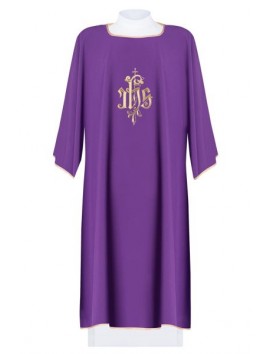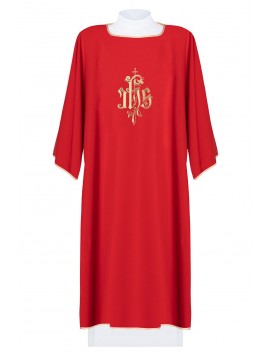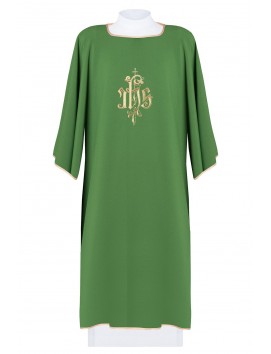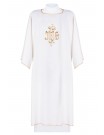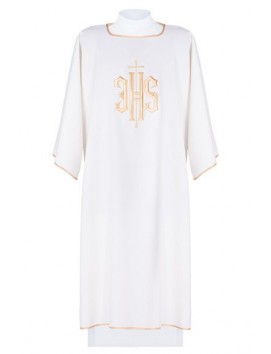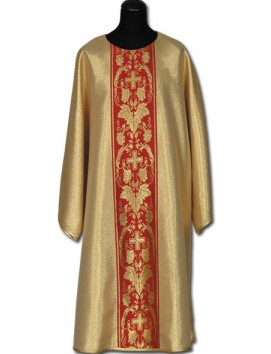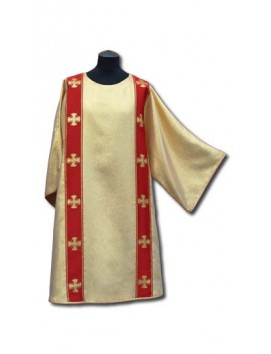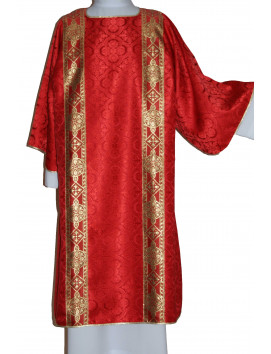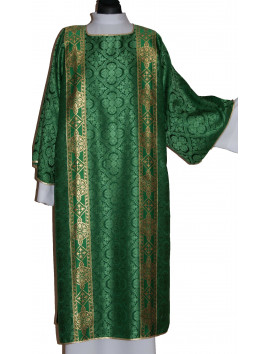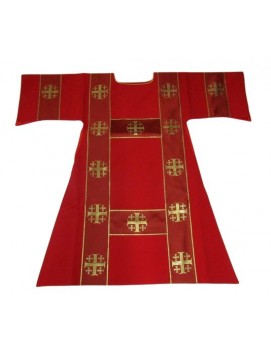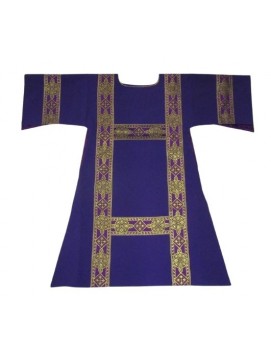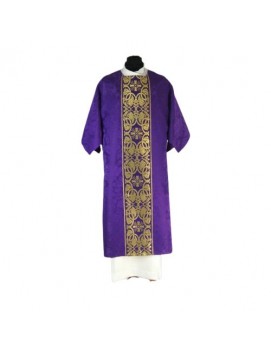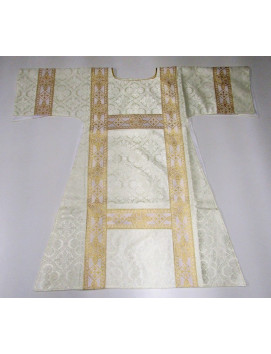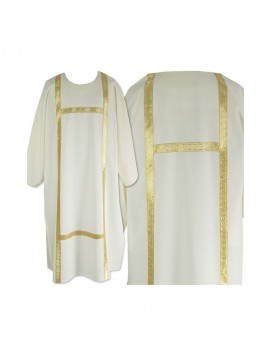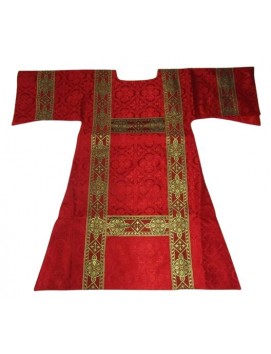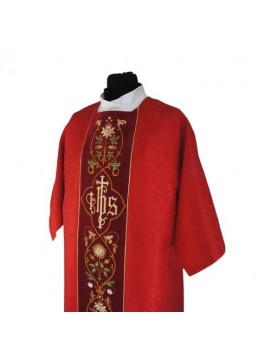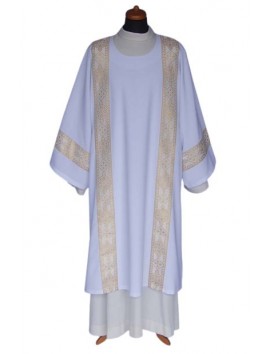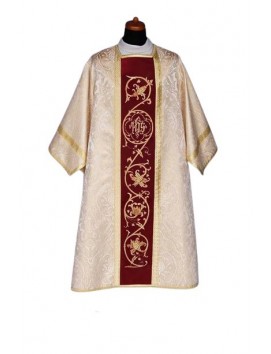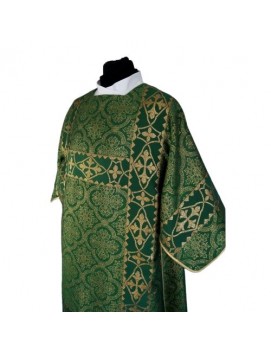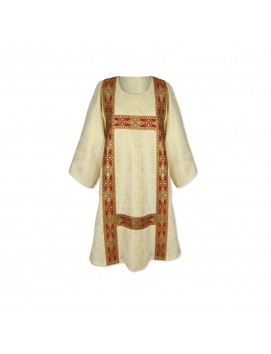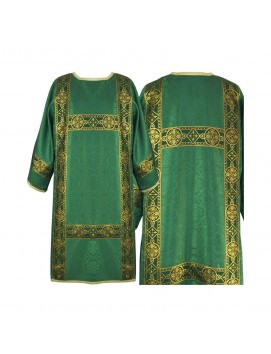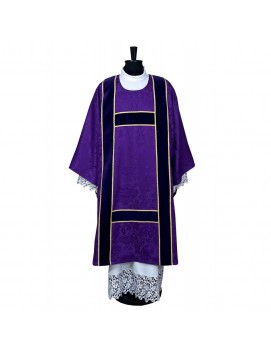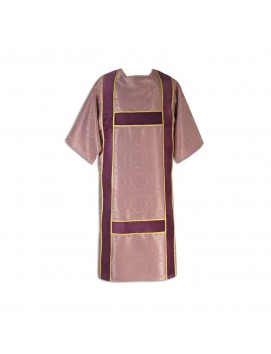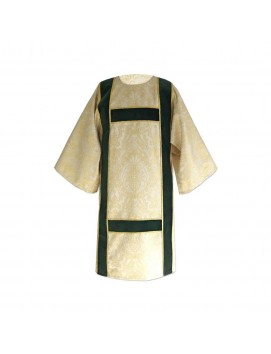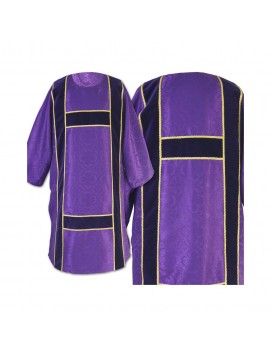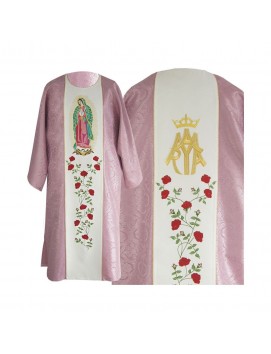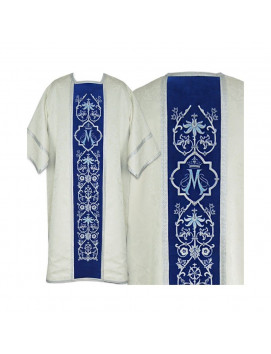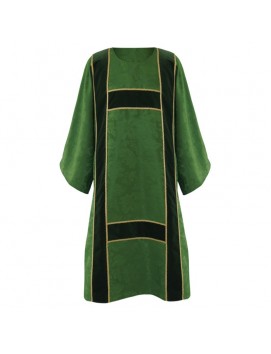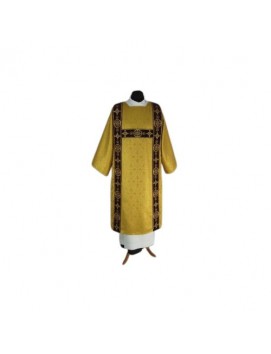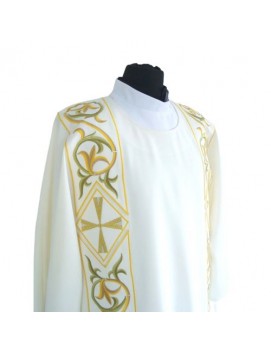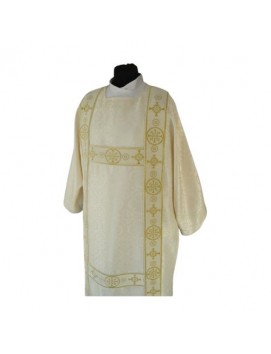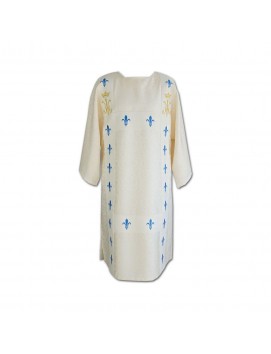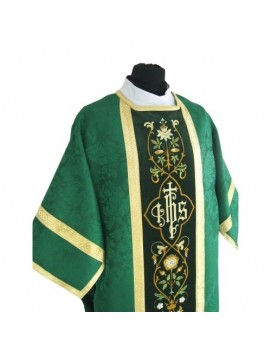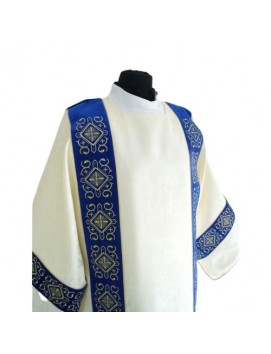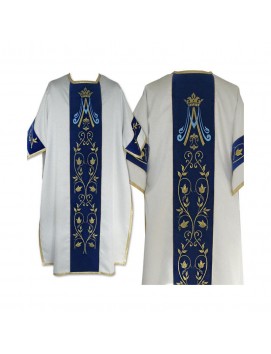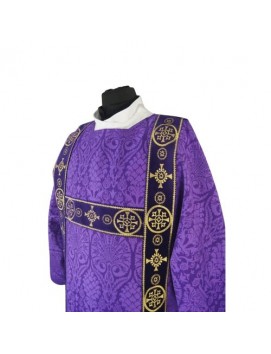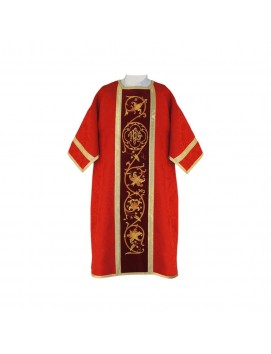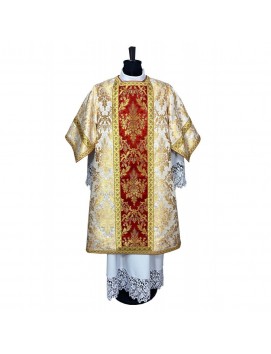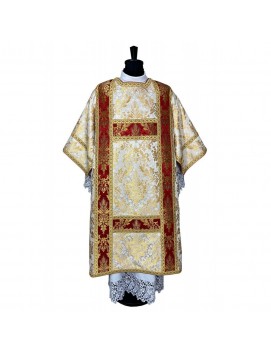No products
Dalmatics
A dalmatic is a long, wide-sleeved tunic that serves as a liturgical vestment in various Christian denominations, including Catholic, Lutheran, Anglican, United Methodist, and some other churches. It is the proper vestment for a deacon during the celebration of the Mass and at solemn processions and benedictions. The dalmatic is a robe with wide sleeves that reaches at least to the knees or lower. It is often decorated with spiritual motifs, such as the Holy Spirit, and is made of high-quality materials, such as silk or wool. The dalmatic was originally a garment of Byzantine dress and was adopted by Emperor Paul I of the Russian Empire as a coronation and liturgical vestment. In Orthodox icons of Jesus Christ as King and Great High Priest, he is shown in a dalmatic. The dalmatic was a normal item of clothing at the time when ecclesiastical clothes began to develop separately around the fourth century, worn over a longer tunic by the upper classes, and as the longest part of the dress of men of lower rank. In 18th-century vestment fashion, it is customary to slit the underside of the sleeves so that the dalmatic becomes a mantle like a scapular with an opening for the head and two square pieces of the material falling from the shoulder over the upper arm. Modern dalmatics tend to be longer and have closed sleeves. Dalmatics can be purchased from various online retailers, and can be custom-made to fit the clergy member's style and preferences.
A dalmatic is a long, wide-sleeved tunic that serves as a liturgical vestment in various Christian denominations, including Catholic, Lutheran, Anglican, United Methodist, and some other churches. It is the proper vestment for a deacon during the celebration of the Mass and at solemn processions and benedictions. The dalmatic is a robe with wide sleeves that reaches at least to the knees or lower. It is often decorated with spiritual motifs, such as the Holy Spirit, and is made of high-quality materials, such as silk or wool. The dalmatic was originally a garment of Byzantine dress and was adopted by Emperor Paul I of the Russian Empire as a coronation and liturgical vestment. In Orthodox icons of Jesus Christ as King and Great High Priest, he is shown in a dalmatic. The dalmatic was a normal item of clothing at the time when ecclesiastical clothes began to develop separately around the fourth century, worn over a longer tunic by the upper classes, and as the longest part of the dress of men of lower rank. In 18th-century vestment fashion, it is customary to slit the underside of the sleeves so that the dalmatic becomes a mantle like a scapular with an opening for the head and two square pieces of the material falling from the shoulder over the upper arm. Modern dalmatics tend to be longer and have closed sleeves. Dalmatics can be purchased from various online retailers, and can be custom-made to fit the clergy member's style and preferences.
-
White dalmatics with gold stripes + stole White dalmatics with gold stripes + stole
White dalmatics with gold stripes + stole White dalmatics with gold...
$ 156 -
Gothic Marian Dalmatic (1) Gothic Marian Dalmatic (1)
Gothic Marian Dalmatic (1) Gothic Marian Dalmatic (1)
$ 355
The Dramatic Dalmatic: A Vestment with a Story
The dalmatic is not just a piece of fabric; it's a narrative woven through time, embodying tradition, symbolism, and the sacred duties of those who wear it. Let's dive into the fascinating world of the dalmatic, exploring its origins, evolution, and the profound meanings it carries within the Christian liturgy.
Origins and Historical Journey
The dalmatic's story begins in the Roman Empire, specifically in Dalmatia, from which it derives its name. Initially, it was a wide-sleeved, long tunic worn by Roman citizens, evolving from a garment criticized for its effeminate appearance to a respected attire among senators and imperial officers. By the 2nd century A.D., it had become a staple of Roman fashion, eventually making its way into the ecclesiastical wardrobe.
Pope Sylvester I, in 314 A.D., introduced the dalmatic into Christian worship, initially reserving it for deacons and the pope himself. While deacons wore it as an outer garment, the pope donned it underneath the chasuble. This distinction set the stage for the dalmatic's liturgical significance, marking it as a symbol of service and sacrifice.
Symbolism and Significance
The dalmatic, with its cruciform shape, has been regarded as a symbol of Christ's sufferings. Its design and the manner it is worn reflect the deep, unfathomable mysteries of faith, such as purity, light, and the Holy Spirit. The liturgical colors of the dalmatic—white, red, green, violet, gold, and silver—each tell a part of the Christian story, from joy and purity to penance and martyrdom.
The Dalmatic Today: Roles and Rituals
In modern liturgical practice, the dalmatic remains a vestment primarily for deacons, signifying their role as servants of the Church and symbols of Christ the Servant. It is worn over the alb and stole during Mass, solemn processions, and benedictions, except in times of fasting and penance when its joyous symbolism is set aside.
Bishops may also wear a dalmatic under the chasuble during solemn occasions, especially ordinations, highlighting the garment's dual symbolism of service and episcopal authority. This practice underscores the unity and continuity within the Church's hierarchy and the shared commitment to serving God's people.
FAQs: Unveiling the Mysteries of the Dalmatic
- What distinguishes a dalmatic from a chasuble?
The dalmatic is characterized by its wide sleeves and is the proper vestment for deacons, while the chasuble, sleeveless and worn by priests, symbolizes the yoke of Christ.
- Can priests wear dalmatics?
Traditionally, dalmatics are reserved for deacons and bishops. However, in certain liturgical functions, priests may wear a dalmatic under specific circumstances, such as when a bishop presides but is not the principal celebrant.
- What does the color of the dalmatic signify?
The color corresponds to the liturgical season or occasion, ranging from white for joy and purity to red for the Holy Spirit and martyrdom, each adding depth and richness to the worship experience.
In conclusion, the dalmatic is more than just a vestment; it's a dramatic symbol of the Christian faith, embodying centuries of tradition, devotion, and service. As we explore its history, symbolism, and current use, we gain a deeper appreciation for the roles and rituals that define the Christian liturgical practice. The dalmatic, with its wide sleeves and rich colors, continues to be a powerful reminder of the Church's enduring mission to serve and uplift the human spirit.

